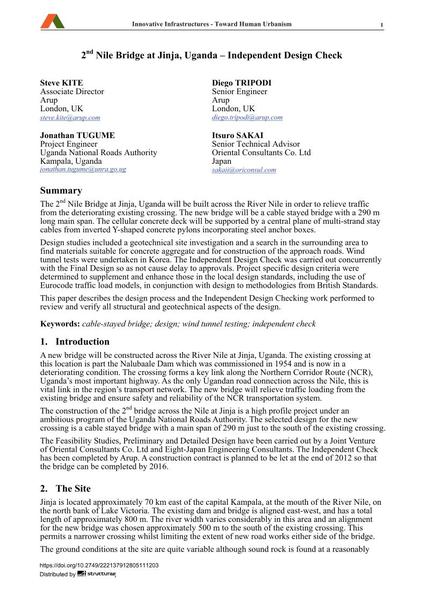2nd Nile Bridge at Jinja, Uganda – Independent Design Check

|
|
|||||||||||
Détails bibliographiques
| Auteur(s): |
Steve Kite
Diego Tripodi Jonathan Tugume Itsuro Sakai |
||||
|---|---|---|---|---|---|
| Médium: | papier de conférence | ||||
| Langue(s): | anglais | ||||
| Conférence: | 18th IABSE Congress: Innovative Infrastructures – Towards Human Urbanism, Seoul, Korea, 19-21 September 2012 | ||||
| Publié dans: | IABSE Congress Seoul 2012 | ||||
|
|||||
| Page(s): | 803-810 | ||||
| Nombre total de pages (du PDF): | 8 | ||||
| DOI: | 10.2749/222137912805111203 | ||||
| Abstrait: |
The 2nd Nile Bridge at Jinja, Uganda will be built across the River Nile in order to relieve traffic from the deteriorating existing crossing. The new bridge will be a cable stayed bridge with a 290 m long main span. The cellular concrete deck will be supported by a central plane of multi-strand stay cables from inverted Y-shaped concrete pylons incorporating steel anchor boxes. Design studies included a geotechnical site investigation and a search in the surrounding area to find materials suitable for concrete aggregate and for construction of the approach roads. Wind tunnel tests were undertaken in Korea. The Independent Design Check was carried out concurrently with the Final Design so as not cause delay to approvals. Project specific design criteria were determined to supplement and enhance those in the local design standards, including the use of Eurocode traffic load models, in conjunction with design to methodologies from British Standards. This paper describes the design process and the Independent Design Checking work performed to review and verify all structural and geotechnical aspects of the design. |
||||
| Mots-clé: |
design Pont à haubans
|
||||
